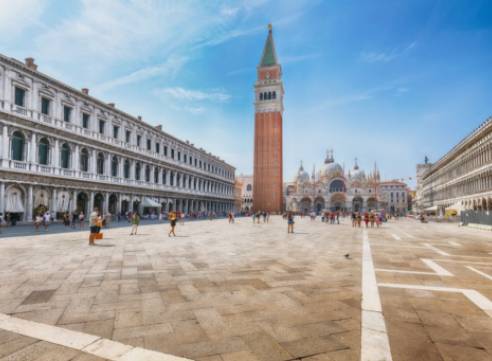A Guide to Traditional Venetian Carnival Costumes
22 December 2025 by Irina G.The Venetian Carnival is known for its elaborate masks and costumes that have been worn for centuries. These intricate designs are steeped in symbolism and tradition, with each costume telling a story of its own. From the mysterious Bauta mask to the playful Columbine costume, there is a wide variety of outfits to choose from when attending this festive event. In this guide, we will explore the most popular traditional masks and costumes of the Venetian Carnival, as well as provide tips on how to create your own unique Venetian-inspired costume using traditional fabrics and materials.

Popular Traditional Masks of the Venetian Carnival
The Venetian Carnival is famous for its elaborate and beautiful masks that have been worn for centuries. These masks are an essential part of the Venetian Carnival tradition, and they come in various styles and designs. Some of the most popular traditional masks of the Venetian Carnival include the iconic Bauta mask, the intricate Colombina mask, the mysterious Medico della Peste mask, and the striking Plague Doctor mask. Each mask has its own unique design and history, adding to the allure and magic of the Venetian Carnival celebration.How to Create Your Own Venetian Carnival Costume
Creating your own Venetian Carnival costume is a fun and creative way to participate in the festive atmosphere of the carnival. To start, choose a character or theme that you would like to embody. Whether you want to be a nobleman in a lavish costume or a mischievous jester, the possibilities are endless. Next, research traditional Venetian costumes and masks to get inspiration for your design. Look for images online or visit costume shops in Venice to see authentic costumes up close. Pay attention to the intricate details and embellishments that make Venetian costumes unique. Once you have a vision for your costume, gather the necessary materials. Traditional Venetian costumes are often made from luxurious fabrics such as silk, velvet, and brocade. Consider incorporating feathers, sequins, and beads for added flair. Don't forget to choose a mask or a headdress to complete your look. To assemble your costume, start by constructing the base garment, such as a robe or a tunic. Add layers of fabric and embellishments to create depth and texture. Pay attention to the details, as Venetian costumes are known for their intricate embroidery and elaborate designs. Finally, accessorize your costume with jewelry, gloves, and shoes to complete the ensemble. Consider adding a cape or a cloak for an extra touch of drama. Once your costume is complete, don't forget to immerse yourself in the carnival spirit by participating in the festivities and events. Creating your own Venetian Carnival costume is a rewarding experience that allows you to embody the rich history and tradition of the Venetian Carnival. Whether you choose to be a mysterious masked figure or a glamorous noblewoman, your costume will surely be a showstopper at the carnival.The Symbolism Behind Venetian Carnival Costumes
The elaborate masks and costumes worn during the carnival carry deep meanings and significance. One of the most iconic symbols of the Venetian Carnival is the mask. Masks were originally worn to conceal the identity of the wearer, allowing people to engage in activities that would otherwise be considered socially unacceptable. The anonymity provided by the mask allowed individuals to freely express themselves and indulge in festivities without fear of judgement or repercussions. In addition to anonymity, masks also symbolize transformation and metamorphosis. By donning a mask, individuals are able to adopt a different persona or identity, breaking free from societal norms and expectations. This sense of liberation and transformation is a central theme of the carnival, where participants can escape their everyday reality and immerse themselves in a world of fantasy and whimsy. The intricate designs and patterns found on Venetian costumes also carry symbolic meaning. Vibrant colors, elaborate embellishments, and luxurious fabrics are often used to convey status, wealth, and extravagance. These elements reflect the opulence of Venetian society during the Renaissance period, when the carnival first emerged as a celebration of excess and indulgence. Moreover, certain motifs and symbols commonly found on Venetian costumes hold specific meanings. For example, the use of feathers, ribbons, and jewels may represent beauty, grace, and elegance. Animal motifs such as lions, birds, and dragons are often used to symbolize strength, courage, and power. Overall, Venetian Carnival costumes are not merely decorative garments worn for festivities, but are imbued with a deeper layer of symbolism and cultural significance. Each costume tells a story, reflecting the history, traditions, and values of the Venetian people.Traditional Fabrics and Materials Used in Venetian Costumes
Some of the most commonly used fabrics in these costumes include:Silk: Silk was a highly prized fabric in Venice during the Renaissance period, and it continues to be a popular choice for Venetian Carnival costumes. The shimmering quality of silk adds a sense of opulence to the garments.
Velvet: Velvet is another fabric commonly used in Venetian Carnival costumes. Its rich texture and deep colors make it a popular choice for creating intricate and detailed costumes.
Brocade: Brocade is a type of fabric woven with a raised pattern or design. It is often used in Venetian Carnival costumes to create a luxurious and ornate look.
Lace: Lace is a delicate fabric commonly used to add a feminine and romantic touch to Venetian Carnival costumes. It is often used as an overlay or trim on garments.
Satin: Satin is a smooth, shiny fabric that adds a luxurious sheen to Venetian Carnival costumes. It is often used for linings, trims, and accessories. In addition to these fabrics, Venetian Carnival costumes may also feature embellishments such as sequins, beads, feathers, and embroidery to add a touch of glamour and sophistication. The use of these materials and fabrics helps to create the intricate and elaborate costumes that are characteristic of the Venetian Carnival tradition.